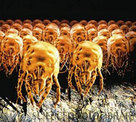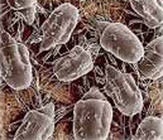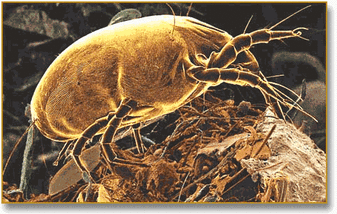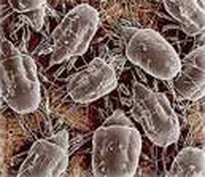Dust Mite Allergies
Are you Sleeping With The Enemy?

Discover What Uninvited Guests are Sharing The Bed With You and Your Family!
Click on the picture above to
watch the shocking video clip!

Learn About Dust Mites, What they Are, Where They Live and What They Eat!
What is a House Dust Mite?
Dust mites, which are scientifically known as dermatophagoides pteronyssinus, are insect-like creatures.
They are natural inhabitants of your home, but because they are microscopic you have probably never seen them.
Their presence does not indicate a lack of cleanliness.
In fact, no matter how meticulously you clean, they can not be entirely eliminated.
Since female dust mites lay 25 to 50 eggs every three weeks.
They are natural inhabitants of your home, but because they are microscopic you have probably never seen them.
Their presence does not indicate a lack of cleanliness.
In fact, no matter how meticulously you clean, they can not be entirely eliminated.
Since female dust mites lay 25 to 50 eggs every three weeks.

Dust mites feed on human skin cells and the average adult sheds 2 pounds of human skin cells per year.
Dust mites live in house dust and feed on flakes of human skin that are contained in the dust particles.
People shed skin flakes constantly, in amounts up tp 1.5 grams per day.
This provides enough nourishment for the dust mites to gorge on and even tides them over during periods when rooms are not entered or used.
House dust mite allergy is not only caused by the dust mites themselves, but also their excrements (feces).
Each mite produces about 20 feces each day causing allergice reactions, even after the mite that produced them is dead.
People shed skin flakes constantly, in amounts up tp 1.5 grams per day.
This provides enough nourishment for the dust mites to gorge on and even tides them over during periods when rooms are not entered or used.
House dust mite allergy is not only caused by the dust mites themselves, but also their excrements (feces).
Each mite produces about 20 feces each day causing allergice reactions, even after the mite that produced them is dead.
Can Dust Mites Cause Allergies?

Dry air during heating periods causes dried mite bodies and body parts to become airborne.
To make matters worse, the finely grained excrement breaks down to an extremely fine powder.
The powder then sticks to surrounding materials such as carpet, upholstery and bedding.
It becomes airborne when you walk on the carpet, sit down or rise from upholstered furniture or bedding.
Attracted to warmth and moisture, mites thrive in mattresses, pillows, towels, carpets, upholstered furniture, and childrens stuffed toys.
The average bed contains 2 million of these creatures, making the bedroom a danger zone for anyone who is sensitive to dust mite allergen.
Constant exposure to mite allergens can lead to chronic (long term) illness.
By taking a few steps to minimize dust mite allergen in your bedroom, along with other areas of your home, it is possible to decrease your allergic symptoms and even medication requirements.
To make matters worse, the finely grained excrement breaks down to an extremely fine powder.
The powder then sticks to surrounding materials such as carpet, upholstery and bedding.
It becomes airborne when you walk on the carpet, sit down or rise from upholstered furniture or bedding.
Attracted to warmth and moisture, mites thrive in mattresses, pillows, towels, carpets, upholstered furniture, and childrens stuffed toys.
The average bed contains 2 million of these creatures, making the bedroom a danger zone for anyone who is sensitive to dust mite allergen.
Constant exposure to mite allergens can lead to chronic (long term) illness.
By taking a few steps to minimize dust mite allergen in your bedroom, along with other areas of your home, it is possible to decrease your allergic symptoms and even medication requirements.

Discover the first step to take in detecting and eleminating these harmful allergens from your home and office.




